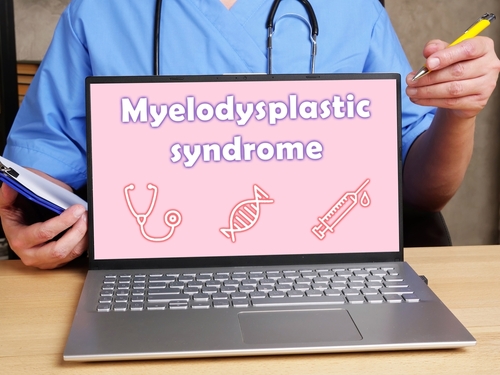
In a new clinical trial, an intensified regimen of busulfan plus fludarabine followed by a combination of cladribine, venetoclax, and thiotepa has been assessed for use as conditioning for allogeneic hematopoietic stem cell transplantation (HSCT) in patients with high-risk acute myeloid leukemia (AML) or myelodysplastic syndrome (MDS).
The prospective phase 2 trial was conducted by a team of researchers from The University of Texas MD Anderson Cancer Center, Houston. Noteworthy among their findings were promising progression-free survival (PFS) results, which they reported at the 2025 Tandem Transplantation & Cellular Therapy Meetings of the ASTCT and CIBMTR in Honolulu, Hawai’i.
The study enrolled 49 patients with an age range of 18 to 69 years and a median age of 59 years. Twenty-five patients were women, and 22% of the cohort had TP53 mutations. For 27% of the patients, the transplant donor was a matched sibling; 55% had a matched but unrelated donor, 12% had a mismatched unrelated donor, and 6% had a haploidentical related donor.
Twenty-five patients in the cohort had AML; 40% had primary refractory or relapsed disease, and 56% had adverse risk disease per the 2022 update of the European LeukemiaNet criteria. Twenty-four patients had MDS; 58% had a revised International Prognostic Scoring System (IPSS) score greater than 3.5; and 83% had a moderately high, high, or very high molecular IPSS score. Forty-seven percent of the total cohort had comorbidity scores of 3 or higher.
The trial involved extending the busulfan plus fludarabine regimen for up to 3 weeks. The patients received outpatient venetoclax 400 mg daily on days –22 to –3 before HSCT; busulfan 100 mg/m2 on days –20 and –13; thiotepa 5 mg/kg on day –7; and fludarabine 10 mg/m2, cladribine 10 mg/m2, and busulfan on days –6 to –3. After HSCT, graft-vs-host disease prophylaxis involved cyclophosphamide 50 mg/kg on days +3 and +4 and tacrolimus with or without mycophenolate mofetil.
The total cohort had a median follow-up of 23 months, and median PFS was not reached. The PFS of 61%, attained at 1 year and 2 years, met the trial’s primary end point. The cohort had a 2-year overall survival rate of 65%, a nonrelapse mortality rate of 22%, and a relapse rate of 16%.
The investigators’ PFS univariate analysis revealed no associations with any of the covariates tested, but their relapse univariate analysis revealed a trend toward higher relapse among patients who had mutations in TP53, with a hazard ratio of 3.693 (P=0.056).
Reference
Popat UR, Bassett RL, Alousi AM, et al. Myeloablative fractionated busulfan, fludarabine, cladribine, thiotepa and venetoclax (cladillac) conditioning regimen for allogeneic stem cell transplantation in very high-risk AML/MDS: a phase 2 trial. Abstract presented at: Tandem Transplantation & Cellular Therapy Meetings of ASTCT and CIBMTR; February 12-15, 2025; Honolulu, HI.







 © 2025 Mashup Media, LLC, a Formedics Property. All Rights Reserved.
© 2025 Mashup Media, LLC, a Formedics Property. All Rights Reserved.